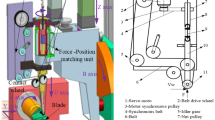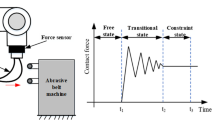Abstract
Precision-cast blades are core components in aeroengines, and their machining precision has a considerable effect on the performance of the aeroengine. In this paper, an adaptive grinding method for precision-cast blades with geometric deviation is proposed to improve the machining precision, machining efficiency, and automation level of precision-cast blade grinding. A scheme for adaptive grinding of precision-cast blades with geometric deviation is developed, a grinding process for precision-cast blades is formulated, and a robotic grinding system is constructed. An optimal model to match the blade measurement data to the design model is then established, and a corresponding optimal matching matrix is solved to determine a position reference for precision-cast blades. Further, the theoretical cutter contacts are extracted, and the machining allowance of the precision-cast blade profile is measured. An estimation model of grinding material removal (MR) of precision-cast blades based on a neural network algorithm is established, and the correctness of the model is verified. Finally, an adaptive grinding experiment is performed on the concave surface (CC) of a precision-cast blade to verify the accuracy of the proposed grinding method. The experimental results show that, after adaptive grinding, the machining allowance of CC is distributed in the range of − 0.05 mm to 0.05 mm, which meets the machining precision requirements of the blade.

















Similar content being viewed by others
References
Huang Y, Xiao GJ, Zou L (2019) Current situation and development trend of robot precise belt grinding for areo-engine blade. Acta Aeronaut Astronaut Sin 40(3):53–72
Volkov DI, Koryazhkin AA (2014) Adaptive belt grinding of gas turbine blades. Russ Eng Res 34(1):37–40
Shi YY, Duan JH, Zhang JF, Dong T (2012) Blisk disc manufacturing process technology. Aeronaut Manuf Technol 399(3):26–31
Wang W, Yuan C (2011) A path planning method for robotic belt surface grinding. Chin J Aeronaut 24(04):520–526
Wang ZQ (2015) Key manufacturing technology of advanced aero-engine. Aeronaut Manuf Technol 492(22):34–38
Kosler, Hubert P, Urban J, Matija M, Janez (2016) Adaptive robotic deburring of die-cast parts with position and orientation measurements using a 3D laser-triangulation sensor. Strojni ki vestnik-J Mech Eng 62(4):207–212
Song HC, Song JB (2013) Precision robotic deburring based on force control for arbitrarily shaped workpiece using CAD model matching. Int J Precis Eng Manuf 14(1):85–91
Wang W, Liu F, Liu ZH, Yun C (2017) Prediction of depth of cut for robotic belt grinding. Int J Adv Manuf Technol 91(1–4):699–708
Liang W, Song YX, Lv HB, Jia PF, Gan ZX, Qi LZ (2010) A novel control method for robotic belt grinding based on SVM and PSO algorithm. International conference on intelligent computation technology and automation 258–261
Xie SB, Li S, Chen B, Qi JD (2017) Research on robot grinding technology considering removal rate and roughness. Intelligent Robotics and Applications ICIRA Lecture Notes in Computer Science 79–90
Yang JH, Zhang DH, Wu BH, Zhang Y, Luo M (2015) A path planning method for error region grinding of aero-engine blades with free-form surface. Int J Adv Manuf Technol 81(1–4):717–728
Ren XG, Kuhlenkoetter B (2008) Real-time simulation and visualization of robotic belt grinding processes. Int J Adv Manuf Technol 35(11–12):1090–1099
Zhang X, Cabaravdic M, Kneupner K, Kuhlenkoetter B (2004) Real-time simulation of robot controlled belt grinding processes of sculptured surfaces. Int J Adv Robot Syst 1(1):109–114
Sun YW, Xu JT, Ren F, Guo Q (2014) High-performance multi-axis precision machining technology and method for complex curved surfaces. China, Beijing
Prieto A, Prieto B, Ortigosa EM, Ros E, Pelayo F, Ortega J, Rojas I (2016) Neural networks: an overview of early research, current frameworks and new challenges. Neurocomputing 214:242–268
Sun K, Wu X, Xue J, Ma F (2019) Development of a new multi-layer perceptron based soft sensor for SO2 emissions in power plant. J Process Control 84:182–191
Kumar S, Jana P (2019) Application of dynamic stiffness method for accurate free vibration analysis of sigmoid and exponential functionally graded rectangular plates. Int J Mech Sci 163:105105
Nielsen MA (2015) Neural networks and deep learning. Determination Press
Acknowledgments
The authors of the paper express their deep gratitude to them for the financial support of research projects.
Funding
This research is supported by the National Key R&D Program of China (Grant No. 2019YFB1703700), the Technology R&D and Application Demonstration Program of Chongqing (Grant No. cstc2018jszx-cyzdX0061), and the Science and Technology Research Program of Chongqing Municipal Education Commission (Grant No. KJZD-M201801101).
Author information
Authors and Affiliations
Corresponding author
Additional information
Publisher’s note
Springer Nature remains neutral with regard to jurisdictional claims in published maps and institutional affiliations.
Rights and permissions
About this article
Cite this article
Zhang, M., Chen, T., Tan, Y. et al. An adaptive grinding method for precision-cast blades with geometric deviation. Int J Adv Manuf Technol 108, 2349–2365 (2020). https://doi.org/10.1007/s00170-020-05520-6
Received:
Accepted:
Published:
Issue Date:
DOI: https://doi.org/10.1007/s00170-020-05520-6




